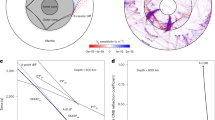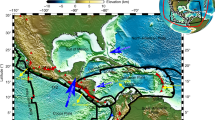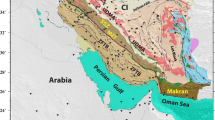Abstract
The origins of ultralow velocity zones, small-scale structures with extremely low seismic velocities found near the core–mantle boundary, remain poorly understood. One hypothesis is that they are mobile features that actively participate in mantle convection, but mantle flow adjacent to ultralow velocity zones is poorly understood and difficult to infer. Although deep mantle anisotropy observations can be used to infer mantle flow patterns, ultralow velocity zone structures are often not examined jointly with these observations. Here we present evidence from seismic waves that sample the lowermost mantle beneath the Himalayas for both an ultralow velocity zone and an adjacent region of seismic anisotropy associated with mantle flow. By modelling realistic mineral physics scenarios using global wavefield simulations, we show that the identified seismic anisotropy is consistent with horizontal shearing orientated northeast–southwest. Based on tomographic data of the surrounding mantle structure, we suggest that this southwestward flow is potentially linked to the remnants of the subducted slab impinging on the core–mantle boundary. The detected ultralow velocity zone is located at the southwestern edge of this anisotropic region, and therefore potentially affected by strong mantle deformation in the surrounding area.
This is a preview of subscription content, access via your institution
Access options
Access Nature and 54 other Nature Portfolio journals
Get Nature+, our best-value online-access subscription
$29.99 / 30 days
cancel any time
Subscribe to this journal
Receive 12 print issues and online access
$259.00 per year
only $21.58 per issue
Buy this article
- Purchase on Springer Link
- Instant access to full article PDF
Prices may be subject to local taxes which are calculated during checkout




Similar content being viewed by others
Data availability
The data used in this study are freely available and were downloaded from the following data centres: Bundesanstalt für Geowissenschaften und Rohstoffe (http://eida.bgr.de), GEOFOrschungsNetz (http://geofon.gfz-potsdam.de), INGV Istituto Nazionale di Geofisica e Vulcanologia (http://webservices.ingv.it), Incorporated Research Institutions for Seismology (http://service.iris.edu), Kandilli Observatory and Earthquake Research Institute (http://eida.koeri.boun.edu.tr), Ludwig-Maximilians-Universität München (http://erde.geophysik.uni-muenchen.de), National Institute for Earth Physics (http://eida-sc3.infp.ro), Observatories and Research Facilities for European Seismology (http://www.orfeus-eu.org), Résif (http://ws.resif.fr) and Swiss Seismological Service (http://www.seismo.ethz.ch/en/research-and-teaching/products-software/waveform-data/), as further specified in the Supplementary Information.
Code availability
The synthetic seismograms for this study were computed using AxiSEM3D31,32, which is publicly available at https://github.com/AxiSEMunity.
References
Yu, S. & Garnero, E. J. Ultralow velocity zone locations: a global assessment. Geochem. Geophys. Geosyst. 19, 396–414 (2018).
McNamara, A. K. A review of large low shear velocity provinces and ultra low velocity zones. Tectonophysics 760, 199–220 (2019).
Thorne, M. S. et al. The most parsimonious ultralow-velocity zone distribution from highly anomalous SPdKS waveforms. Geochem. Geophy. Geosyst. 22, e2020GC009467 (2021).
Hansen, S. E., Garnero, E. J., Li, M., Shim, S.-H. & Rost, S. Globally distributed subducted materials along the Earth’s core–mantle boundary: implications for ultralow velocity zones. Sci. Adv. 9, eadd4838 (2023).
McNamara, A. & Zhong, S. Thermochemical structures beneath Africa and the Pacific Ocean. Nature 437, 1136–1139 (2005).
McNamara, A. K., Garnero, E. J. & Rost, S. Tracking deep mantle reservoirs with ultra-low velocity zones. Earth Planet. Sci. Lett. 299, 1–9 (2010).
Tackley, P. J. Living dead slabs in 3-D: the dynamics of compositionally-stratified slabs entering a “slab graveyard" above the core–mantle boundary. Phys. Earth Planet. Inter. 188, 150–162 (2011).
Li, M. The formation of hot thermal anomalies in cold subduction-influenced regions of Earth’s lowermost mantle. J. Geophys. Res. Solid Earth 125, e2019JB019312 (2020).
Lai, V. H. et al. Strong ULVZ and slab interaction at the northeastern edge of the Pacific LLSVP favors plume generation. Geochem. Geophys. Geosyst. 23, e2021GC010020 (2022).
van der Meer, D. G., van Hinsbergen, D. J. & Spakman, W. Atlas of the underworld: slab remnants in the mantle, their sinking history, and a new outlook on lower mantle viscosity. Tectonophysics 723, 309–448 (2018).
Qayyum, A. et al. Subduction and slab detachment under moving trenches during ongoing India–Asia convergence. Geochem. Geophys. Geosyst. 23, e2022GC010336 (2022).
Amaru, M. Global Travel Time Tomography With 3-D Reference Models. PhD dissertation, Utrecht Univ. (2007).
Simmons, N. A., Forte, A. M., Boschi, L. & Grand, S. P. GyPSuM: A joint tomographic model of mantle density and seismic wave speeds. J. Geophys. Res. Solid Earth 115, B12310 (2010).
Asplet, J., Wookey, J. & Kendall, M. A potential post-perovskite province in D″ beneath the eastern Pacific: evidence from new analysis of discrepant SKS–SKKS shear-wave splitting. Geophys. J. Int. 221, 2075–2090 (2020).
Wolf, J. & Long, M. D. Slab-driven flow at the base of the mantle beneath the northeastern Pacific Ocean. Earth Planet. Sci. Lett. 594, 117758 (2022).
Long, M. D. & Becker, T. Mantle dynamics and seismic anisotropy. Earth Planet. Sci. Lett. 297, 341–354 (2010).
Wolf, J., Long, M. D., Li, M. & Garnero, E. Global compilation of deep mantle anisotropy observations and possible correlation with low velocity provinces. Geochem. Geophys. Geosyst. 24, e2023GC011070 (2023).
Cottaar, S. & Romanowicz, B. An unsually large ULVZ at the base of the mantle near Hawaii. Earth Planet. Sci. Lett. 355–356, 213–222 (2012).
Cottaar, S. & Romanowicz, B. Observations of changing anisotropy across the southern margin of the African LLSVP. Geophys. J. Int. 195, 1184–1195 (2013).
Wolf, J. & Long, M. D. Lowermost mantle structure beneath the central Pacific Ocean: ultralow velocity zones and seismic anisotropy. Geochem. Geophys. Geosyst. 24, e2022GC010853 (2023).
Li, M., McNamara, A., Garnero, E. & Yu, S. Compositionally-distinct ultra-low velocity zones on Earth’s core–mantle boundary. Nat. Commun. 8, 177 (2017).
Wolf, J., Long, M. D., Creasy, N. & Garnero, E. On the measurement of Sdiff splitting caused by lowermost mantle anisotropy. Geophys. J. Int. 233, 900–921 (2023).
Long, M. D. & Silver, P. G. Shear wave splitting and mantle anisotropy: measurements, interpretations, and new directions. Surv. Geophys. 30, 407–461 (2009).
Wolf, J. et al. Observations of mantle seismic anisotropy using array techniques: shear-wave splitting of beamformed SmKS phases. J. Geophys. Res. Solid Earth 128, e2022JB025556 (2023).
Hein, G., Kolínský, P., Bianchi, I., Bokelmann, G. & Group, A. W. Shear wave splitting in the Alpine region. Geophys. J. Int. 227, 1996–2015 (2021).
Chevrot, S. Multichannel analysis of shear wave splitting. J. Geophys. Res. Solid Earth 105, 21579–21590 (2000).
Tesoniero, A., Leng, K., Long, M. D. & Nissen-Meyer, T. Full wave sensitivity of SK(K)S phases to arbitrary anisotropy in the upper and lower mantle. Geophys. J. Int. 222, 412–435 (2020).
Wolf, J., Long, M. D., Leng, K. & Nissen-Meyer, T. Constraining deep mantle anisotropy with shear wave splitting measurements: challenges and new measurement strategies. Geophys. J. Int. 230, 507–527 (2022).
Li, Z., Leng, K., Jenkins, J. & Cottaar, S. Kilometer-scale structure on the core–mantle boundary near Hawaii. Nat. Commun. 13, 2787 (2022).
Frost, D. A., Romanowicz, B. & Roecker, S. Upper mantle slab under Alaska: contribution to anomalous core-phase observations on south-Sandwich to Alaska paths. Phys. Earth Planet. Inter. 299, 106427 (2020).
Leng, K., Nissen-Meyer, T. & van Driel, M. Efficient global wave propagation adapted to 3-D structural complexity: a pseudospectral/spectral-element approach. Geophys. J. Int. 207, 1700–1721 (2016).
Leng, K., Nissen-Meyer, T., van Driel, M., Hosseini, K. & Al-Attar, D. AxiSEM3D: broad-band seismic wavefields in 3-D global Earth models with undulating discontinuities. Geophys. J. Int. 217, 2125–2146 (2019).
Dziewonski, A. M. & Anderson, D. L. Preliminary reference Earth model. Phys. Earth Planet. Inter. 25, 297–356 (1981).
Murakami, M., Hirose, K., Kawamura, K., Sata, N. & Ohishi, Y. Post-perovskite phase transition in MgSiO3. Science 304, 855–858 (2004).
Stackhouse, S., Brodholt, J. P., Wookey, J., Kendall, J.-M. & Price, G. D. The effect of temperature on the seismic anisotropy of the perovskite and post-perovskite polymorphs of MgSiO3. Earth Planet. Sci. Lett. 230, 1–10 (2005).
Wentzcovitch, R. M., Tsuchiya, T. & Tsuchiya, J. MgSiO3 postperovskite at D″ conditions. Proc. Natl Acad. Sci. USA 103, 543–546 (2006).
Creasy, N., Miyagi, L. & Long, M. D. A library of elastic tensors for lowermost mantle seismic anisotropy studies and comparison with seismic observations. Geochem. Geophys. Geosyst. 21, e2019GC008883 (2020).
Walker, A. M., Forte, A. M., Wookey, J., Nowacki, A. & Kendall, J.-M. Elastic anisotropy of D″ predicted from global models of mantle flow. Geochem. Geophys. Geosyst. 12, Q10006 (2011).
Forte, A. Constraints on seismic models from other disciplines - implications for mantle dynamics and composition. Treatise Geophys. 1, 805–858 (2015).
Flament, N. Present-day dynamic topography and lower-mantle structure from palaeogeographically constrained mantle flow models. Geophys. J. Int. 216, 2158–2182 (2018).
Reiss, M. & Rümpker, G. SplitRacer: MATLAB code and GUI for semiautomated analysis and interpretation of teleseismic shear-wave splitting. Seismol. Res. Lett. 88, 392–409 (2017).
Silver, P. G. & Chan, W. W. Shear wave splitting and subcontinental mantle deformation. J. Geophys. Res. Solid Earth 96, 16429–16454 (1991).
Nowacki, A., Wookey, J. & Kendall, J.-M. Deformation of the lowermost mantle from seismic anisotropy. Nature 467, 1091–1094 (2010).
Walsh, E., Arnold, R. & Savage, M. K. Silver and Chan revisited. J. Geophys. Res. Solid Earth 118, 5500–5515 (2013).
Reiss, M., Long, M. D. & Creasy, N. Lowermost mantle anisotropy beneath Africa from differential SKS–SKKS shear-wave splitting. J. Geophys. Res. Solid Earth 124, 8540–8564 (2019).
Ekström, G., Nettles, M. & Dziewonski, A. The global CMT project 2004–2010: centroid-moment tensors for 13,017 earthquakes. Phys. Earth Planet. Inter. 200–201, 1–9 (2012).
Wolf, J., Long, M. D., Leng, K. & Nissen-Meyer, T. Sensitivity of SK(K)S and ScS phases to heterogeneous anisotropy in the lowermost mantle from global wavefield simulations. Geophys. J. Int. 228, 366–386 (2022).
Wessel, P. & Smith, W. H. F. New, improved version of Generic Mapping Tools released. Eos 79, 579–579 (1998).
Hosseini, K. et al. SubMachine: web-based tools for exploring seismic tomography and other models of Earth’s deep interior. Geochem. Geophys. Geosyst. 19, 1464–1483 (2018).
Beyreuther, M. et al. ObsPy: a Python toolbox for seismology. Seismol. Res. Lett. 81, 530–533 (2010).
Walker, A. & Wookey, J. MSAT—a new toolkit for the analysis of elastic and seismic anisotropy. Comput. Geosci. 49, 81–90 (2012).
Acknowledgements
This work was funded by Yale University and by the US National Science Foundation via grant no. EAR-2026917 to M.D.L. and grant no. EAR-2027181 to D.A.F. We are grateful for helpful conversations with C. Martin and S. Cottaar.
Author information
Authors and Affiliations
Contributions
Conceptualization was carried out by J.W. and M.D.L. Data analysis was performed by J.W. and D.A.F. Synthetic modelling was carried out by J.W. J.W., M.D.L. and D.A.F. were responsible for methodology. Visualization was carried out by J.W. J.W. and M.D.L. wrote the paper.
Corresponding author
Ethics declarations
Competing interests
The authors declare no competing interests.
Peer review
Peer review information
Nature Geoscience thanks Samantha Hansen, Barbara Romanowicz and Sebastian Rost for their contribution to the peer review of this work. Primary Handling Editors: Alireza Bahadori and James Super, in collaboration with the Nature Geoscience team.
Additional information
Publisher’s note Springer Nature remains neutral with regard to jurisdictional claims in published maps and institutional affiliations.
Extended data
Extended Data Fig. 1 Synthetic and real transverse component (left column) and radial component (right column) velocity seismograms for event 1.
Seismograms are stacked linearly in 1.5° azimuth bins, after alignment to their maximum transverse amplitudes. Stacks are shown in black and individual seismograms in gray. Red lines indicate approximate arrival times. a AxiSEM3D synthetics using the 3D tomography model GyPSuM for Sdiff waveforms. Predicted radial amplitudes are very small, especially for large azimuths. Seismograms are normalized to maximum transverse amplitudes. b Real Sdiff waveforms with the same plotting conventions are in panel a. c Real SKS waveforms for a different event (2016-06-05) with a more favorable initial polarization for SKS analysis. Pink bars indicate the azimuths at which Sdiff is strongly split while SKS is not (compare panels b and c). Seismograms are normalized to maximum radial amplitudes.
Extended Data Fig. 2 Splitting diagnostic plots from SplitRacer that show an example of differential SKS-SKKS splitting recorded at seismic station BAR2 for an event that occurred on May 23, 2013.
a SKS splitting; top panel: Radial (R) and transverse (T) component waveforms. The PREM-predicted SKS arrival time is shown as a green line, and the start/end of the 30 randomly chosen measurement time windows with orange lines. Bottom left: Elliptical SKS particle motion. b Same as panel a for the SKKS phase. The SKKS particle motion is closer to linear than for SKS. Therefore, SKS-SKKS splitting is discrepant.
Extended Data Fig. 3 Beamforming results.
a Beamformed transverse velocity seismograms for event 1, showing the raw Sdiff beams as a function of azimuth. Beams are bandpass-filtered to retain periods between 7 and 20 and aligned with respect to the maximum Sdiff amplitudes. b As panel a but beams are stacked in the same way as single-station data, in 1.5° azimuthal intervals. Beams are shown in gray and stacks in black. In both panels, postcursors are visible. c Example subarray for which we conduct beamforming. Stations, shown as inverted triangles (see legend), are located in Italy. The backazimuth from which the Sdiff wave is predicted to arrive is shown at the central station as a black line. d Upper panel: F-Trace amplitude as a function of backazimuth and arrival time (see legend). The maximum F-Trace value is shown as a green circle. The time window for which beamforming was performed is indicated by dashed violet lines. Lower panel: Single station seismograms are shown in as black lines and the beam as a pink solid line. e Plotting conventions are the same as in panel d but beamforming was performed for the postcursor, which arrives from a slightly different backazimuth than the main Sdiff arrival (panel d). To amplify the weak postcursor, the color scale in panel e is saturated by 10 times relative that in d. The postcursor arrives from a more northerly backazimuth than the main Sdiff phase, as expected for a ULVZ in our suggested location.
Supplementary information
Supplementary Information
Supplementary Text, Supplementary Figs. 1–24, and Supplementary Tables 1 and 2.
Rights and permissions
Springer Nature or its licensor (e.g. a society or other partner) holds exclusive rights to this article under a publishing agreement with the author(s) or other rightsholder(s); author self-archiving of the accepted manuscript version of this article is solely governed by the terms of such publishing agreement and applicable law.
About this article
Cite this article
Wolf, J., Long, M.D. & Frost, D.A. Ultralow velocity zone and deep mantle flow beneath the Himalayas linked to subducted slab. Nat. Geosci. 17, 302–308 (2024). https://doi.org/10.1038/s41561-024-01386-5
Received:
Accepted:
Published:
Issue Date:
DOI: https://doi.org/10.1038/s41561-024-01386-5



